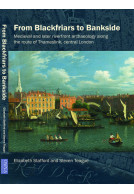Google Books previews are unavailable because you have chosen to turn off third party cookies for enhanced content. Visit our cookies page to review your cookie settings.
Living and Dying in Southwark 1587-1831 (Hardback)
Excavations at Cure's College Burial Ground, Park Street
Imprint: OAPCA
Series: Thameslink Archaeological Series
Pages: 156
Illustrations: 68 illustrations, 48 tables
ISBN: 9780995663619
Published: 13th October 2017
Script Academic & Professional
Series: Thameslink Archaeological Series
Pages: 156
Illustrations: 68 illustrations, 48 tables
ISBN: 9780995663619
Published: 13th October 2017
Script Academic & Professional
You'll be £13.00 closer to your next £10.00 credit when you purchase Living and Dying in Southwark 1587-1831. What's this?
+£4.99 UK Delivery or free UK delivery if order is over £40
(click here for international delivery rates)
Order within the next 7 hours, 45 minutes to get your order processed the next working day!
Need a currency converter? Check XE.com for live rates
(click here for international delivery rates)
Order within the next 7 hours, 45 minutes to get your order processed the next working day!
Need a currency converter? Check XE.com for live rates
The Thameslink Project, a major infrastructure upgrade focussed at Blackfriars Station and London Bridge Station, and along the New Borough viaduct, involved archaeological investigations at Park Street which included the excavation of 331 post-medieval skeletons. The burials were associated with Cure’s College Almshouse, St Saviour’s parish, and dated between 1587 and 1831. Park Street is the first sizeable post-medieval almshouse burial assemblage to be archaeologically examined and, as such, provides a wealth of new information on living – and dying – in London during the 16th to 19th centuries.
By bringing together the archaeological, historical, artefactual, osteological and isotopic evidence, this volume traces the development of the burial ground and builds a social and biological profile of the individuals buried there. A predominantly working class group, these individuals were not among the poorest of the parish, but neither were they wealthy. They hailed from the locality and beyond, as far as continental Europe, and worked as labourers, tradesmen, and skilled craftsmen. Diseases identified on the skeletons attest to nutritional deprivation and living conditions which were defined by poor sanitation, over-crowding and atmospheric pollution, while burial practice reflects pressure on burial space at a time when epidemics and high mortality were a major problem in large suburban parishes such as St Saviour’s.
Other titles in the series...
Other titles in OAPCA...












